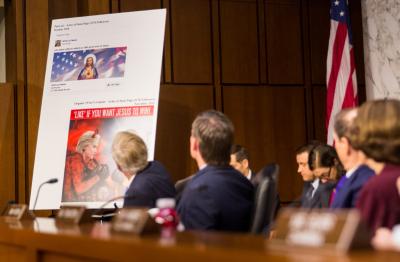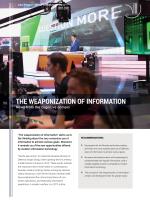The weaponization of information
■ Be aware that disinformation will increasingly be complemented with regular information used in a highly targeted manner as enabled by modern information technology.
■ The concept of “the weaponization of information” needs to be developed further for greater clarity.
“The weaponization of information” alerts us to the thinking about the very conscious use of information to achieve various goals. Moreover, it reminds us of the new opportunities offered by modern information technology.
“Words also shoot”. So noted the Russian Minister of Defence Sergei Shoigu when opening the first military media festival in Russia in 2015. These words indicate the important role of information in contemporary Russian military thinking. Earlier writings by General Valery Gerasimov, Chief of the Russian General Staff, have emphasised the critical importance of non-kinetic operations, and especially information operations, in modern warfare. In a 2017 article, Gerasimov went even further, arguing that in the future war may be exclusively non-kinetic, thereby pointing in the direction of a still greater role for information operations.
The concept of “the weaponization of information” is increasingly being employed to describe such thinking, that is, the very conscious use of information, true or false, to achieve goals ranging from the tactical to the strategic through an active learning process on part of the target. This brings the operation into the cognitive domain, as the ultimate objective of the release of information is to shape the target’s preferences in line with the pre-defined aims of the sender. If achieved, this will be a complex or deep (as opposed to simple or shallow) learning process, whereby the message will be internalized by the target and will inform the target’s formation of preferences. The sender will often rely on state-of-the-art insights from the behavioural sciences, taking advantage of psychological heuristics to facilitate the process.
The sender will often rely on state-of-the-art insights from the behavioral science, taking advantage of psychological heuristicsto facilitate the process.
“The weaponization of information” alerts us to this thinking and to the new opportunities provided by modern information technology. While the most important part of the operation takes place in the cognitive domain, the digital domain is the scene for the transfer of information from sender to target. In other words, new information technology is the force multiplier, which allows a sender to reach a global audience instantly and with a massive amount of information in the hope of influencing modes of thought.
Not all information flows represent a weaponization of information, and it would be highly disruptive for regular communication between actors to view them as such. More work is needed to help users distinguish between information flows that are fully regular and merely part of day-to-day communication, and those that are consciously designed to have a cognitive impact on the target. The weaponization label currently lacks analytical clarity and is used too uncritically.
The information toolbox
Much attention is being and should be paid to disinformation delivered by media platforms controlled by the Russian state. However, awareness is growing that the information toolbox contains much more than made-up stories. It includes, for instance, heavily biased news reporting, targeted political advertising and social media commentaries, as well as the public release of script, sound and imagery gathered by intelligence.
To illustrate the first tool, in January 2017 the US intelligence community described how RT America, an internet and television channel financed by the Russian state but operating in the USA, “has substantially expanded its repertoire of programming that highlights criticism of alleged US shortcomings in democracy and civil liberties”. The charge was not disinformation as such but rather heavily biased reporting, or, as the US intelligence community claimed, RT America conducting “strategic messaging for [the] Russian government”. In September 2017, the US Department of Justice proceeded to request that RT America register as a “foreign agent”, which the company then did, under protest, in November 2017.
As this registration was being filed, the Russian Duma took steps to prepare new legislation forcing media outlets with foreign financing to declare themselves “foreign agents” as well before their respective audiences or to face a ban on their activities in Russia. Russian officials point to Voice of America and Radio Free Europe/Radio Liberty as media outlets likely to suffer as a result of this new legislation (both are funded by the US Congress). This example also illustrates how accusations of the weaponization of information are exchanged and, in so far as these accusations are true, how states may use information in an attempt to influence various targets.
The means of delivery are many, and they may all combine regular information with disinformation. On traditional media platforms, consumers find hosts, expert commentators and politicians being invited to deliver the official scripts, largely unopposed. On social media platforms, users find trolls operating under assumed identities, automated bots, video bloggers and, as the most recent phenomenon, targeted political ads popping up on their screens. The main medium of influence is normative power, seen here as the ability to define acceptable standards of behaviour, that is, to define what is right and wrong. Again the purpose is to shape the target’s political preferences.
From this list of examples, a few deserve special mention. First, we are likely to see a still stronger campaign against traditional expertise with the aim of undermining its status, coupled with a simultaneous widening of alternative expertise, as Russian media platforms will rely still more on their “own” experts, preferably Western and thus non-Russian, to deliver the required messages.
Secondly, as flow television continues to decline, Russian media campaigners are increasingly looking to video bloggers as a way to reach younger audiences especially. This is still mainly a domestic phenomenon, as young Russian video-bloggers address their Russian peers with more or less open political messaging. This is likely to be expanded, however, leading to a finer network of Russian-supported video bloggers operating internationally.
Thirdly, Russian-sponsored target-specific messaging through ads on social media such as Facebook, as witnessed in the 2016 US presidential election, will clearly be a major tool in the future. Relying on marketed data harvested by the social media platforms themselves, the Russian authorities may tailor ads to match the target’s personality, taking full advantage of any psychological vulnerabilities.
As the US authorities in particular discuss how to regulate this field in order to prevent foreign governments from using social media data for their own political purposes, there is a concern that foreign senders of political messages may still find loopholes allowing them to operate undetected. Moreover, it is important to keep in mind that large parts of the former Soviet Union and even neighbouring areas operate in a Russian-dominated social media space, where sites such as VKontakte and Odnoklassniki provide the Russian authorities with easy access to large population groups. This is particularly important, as these are contested normative spaces, where preferences are relatively fluid.

The strategic goals
As mentioned earlier, information may be used to achieve goals ranging from the tactical to the strategic. Strategic operations are usually executed over longer periods of time and may be rooted in meta-narratives about, for instance, military conflict or normative clashes between different actors. These meta-narratives may then serve as stories in their own right and may inform lesser narratives or even the daily news.
It has been reported that the Russian regime instructs the main media outlets on the overall themes to be presented to domestic and international audiences on a weekly basis. This happens inside the walls of the Kremlin, as editors are summoned to meetings with key members of the presidential administration and then proceed to take these purely verbal instructions back to their media offices. On top of this, the meta-narratives define the outer limits of a media playing field. It is highly problematic for individual journalists, editors and media outlets as a whole to step over to the other side. The meta-narratives must be respected, and they guide much of the information flow. A few meta-narratives may be mentioned here for purposes of illustration:
- The West attempts to impose its system of governance on other states, relying on so-called colour revolutions, armed revolts and even military interventions to achieve this objective. Afghanistan, Iraq, Libya, Syria and Ukraine are said to represent the most recent proof of this claim. For instance, the alleged coup in Ukraine in February 2014 is claimed to have been of Western design, and subsequent developments in this country are interpreted through this lens and as a conflict between progressive and reactionary forces.
- The citizens of Western states cannot trust their public institutions. Hidden agendas stand in the way of the truth. These agendas may include designs to impose a particular system of governance on other states, secure access to their natural resources or to bring in cheap labour in the form of asylum-seekers from developing countries. Common to these themes is the claim that the citizens of Western states are denied insights into the full picture. They should, as RT’s slogan famously suggests, “Question more”. Russia’s state-controlled flow of information may also feed into conspiracy media platforms in the West, thereby amplifying the messages.
- The West is morally inferior to Russia, where strong political and spiritual leadership has succeeded in shielding the population from the West’s decay. “Gayropa”, the homo-sexualized and effeminate Europe usually associated with the EU, is the pejorative term used to summarize this decay. A recurrent theme at the strategic level, this flow of information may serve to legitimize the current Russian regime, domestically as well as internationally, and to weaken support for the normative order that currently prevails in Europe. This order is expressed, for instance, in the fundamental treaties of the EU, the Council of Europe and the rulings of the European Court of Human Rights.
DIIS Experts



